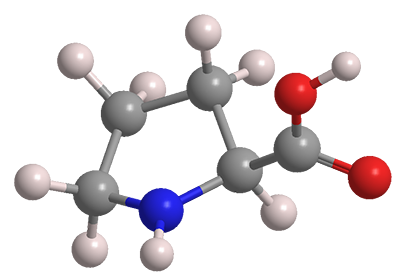What molecule am I?


The amino acid L-proline is considered to be nonessential because humans and other animals can biosynthesize it, mainly from another nonessential amino acid L-glutamic acid. Proline is unusual in that it is heterocyclic, and thus is the only natural amino acid that contains a secondary amine group. Only the L-enantiomer is found in nature.
Proline also is unusual because it was synthesized before it was isolated from natural sources. In 1900, chemistry Nobel Prize–winning German chemist Richard M. Willstätter prepared the D,L-racemate from N-methylproline. The following year, Emil Fischer, another German Nobel laureate, isolated the L-form from egg albumen and hydrolyzed casein.
Proline, like all natural amino acids, is used for biosynthesizing proteins. The rigid five-membered ring in proline gives proteins made from it significantly different secondary structures from proteins made from open-chain proteins.
In 2002, Mohammed Movassaghi and Eric N. Jacobsen at Harvard University introduced the notion that proline is the “simplest enzyme”. At that time, several researchers were using proline as an asymmetric catalyst as though it was a new thing; earlier work using proline had been overshadowed by the advent of metal-based asymmetric catalysts. Movassaghi and Jacobsen declared that it was high time for chemists to realize that asymmetry could be achieved with simple compounds and without the use of metals.
A few years later, Eric Smith of the Santa Fe Institute and coauthors elaborated on the simplest enzyme concept. They argued that “small molecule catalysis is a finding of utmost importance for the origin of biochemistry”. In other words, small molecules, and not large, complex enzymes, were the only catalysts available to promote prebiotic evolution.
L-Proline fast facts
| CAS Reg. No. | 147-85-3 |
| Molar mass | 115.13 g/mol |
| Formula | C5H9NO2 |
| Appearance | White crystals |
| Melting point | 205–228 ºC (dec.)* |
| Water solubility | 162 g/L |
MOTW update:
November 5, 2018
L-Alanine and L-serine were the Molecules of the Week for October 29, 2018. They, along with glycine and L-proline, are the chief amino acids that make up spider silk proteins. In the past month, chemists at San Diego State University and Northwestern University (Evanston, IL) discovered that before spiders spin their silk, they store the silk proteins in complex nanoparticles.

Learn more about this molecule from CAS, the most authoritative and comprehensive source for chemical information.
Molecule of the Week needs your suggestions!
If your favorite molecule is not in our archive, please send us a message. The molecule can be notable for its current or historical importance or for any quirky reason. Thank you!
Stay Ahead of the Chemistry Curve
Learn how ACS can help you stay ahead in the world of chemistry.

